All the limits of the agreement between the EU, Israel and Egypt on gas

The memorandum on gas exports from Israel and Egypt to the EU does not specify either quantity or timing. Tel Aviv and Cairo, then, must strengthen extraction and plants, while Brussels must resolve the taxonomy issue. All the details
On Wednesday 15 June, the European Union signed a memorandum of understanding with Israel and Egypt on the increase in natural gas exports to the Old Continent. The agreement essentially provides for Israeli gas to be sent to Egypt through existing pipes; there it will be liquefied and re-exported to Europe. However, the document does not provide details either on gas volumes or on the completion times of the infrastructures necessary to support the growth of flows.
The pact is part of the Brussels plan to quickly reduce energy dependence on Russia after the invasion of Ukraine, which is particularly strong on gas: Moscow is the first supplier of the block, with a share of about 40 per cent of the total. imported to the Community.
ISRAEL AND EGYPT HAVE A PROBLEM
Both Israel and Egypt have discovered important gas fields in recent years and boosted exports, but their energy cooperation with Europe is limited by an underlying reality: Tel Aviv and Cairo have been repeating for months – as we reported on Startmag , even recently – that it does not have sufficient volumes to satisfy European needs as well.
In 2021, the European Union imported around 155 billion cubic meters per year from Russia.
Also in 2021, Egypt exported 8.9 billion cubic meters of liquefied gas (LNG), and 4.7 billion in the first five months of this year alone. However, the loads are directed mainly to Asia, and the increase in domestic energy demand is reducing the volumes destined for foreign markets.
Israel plans to double its gas output within a few years, bringing it to 40 billion cubic meters per year, through the opening of new fields and the expansion of projects already underway. At the moment, however, most of its production capacity is committed to Egypt and Jordan, in addition to satisfying domestic needs: in short, it does not have much gas left to send to Europe.
GAS IN EUROPEAN TAXONOMY
The trilateral memorandum signed on Wednesday addresses the issue of Israeli and Egyptian production capacity: it provides for Brussels to encourage European companies to participate in gas exploration in Egypt and Israel. However, if in July the European Parliament were to reject the Commission's taxonomy (ie the rules that serve to direct financial capital towards destinations with a positive environmental impact), and therefore not consider gas a "sustainable" source, the hypothetical investments in fields of Israeli and Egyptian hydrocarbons could get more complicated.
THE TIMES FOR THE PLANTS
Beyond gas production, time is needed to upgrade Egypt's liquefaction capacity so that the country can process and export significantly larger quantities of LNG. It will probably take a couple of years to adapt the infrastructure.
The European Commission plans to import 7 billion cubic meters of LNG from Egypt in 2022, and double next year.
BEYOND GAS
Natural gas will probably continue to play a central role in the European energy mix until 2030, stabilizing a system increasingly dominated by intermittent renewable sources (wind and solar) at least until energy storage technologies (batteries ) better and cheaper.
In the twenty years between 2030 and 2050, gas consumption in Europe should then decrease, in order to allow the achievement of the carbon neutrality goal (the net elimination of greenhouse gas emissions) by the middle of the century.
Consequently, energy cooperation between Brussels, Tel Aviv and Cairo will have to evolve and go beyond gas . There is already the intention – should be announced in November at COP27, the climate conference – to establish a partnership on green hydrogen, i.e. generated by renewable electricity, between the European Union and Egypt (the coast of Red sea has great potential). Another project consistent with the ecological transition path is the EuroAsia interconnector, a submarine cable that will move electricity generated in Israel (from gas or renewables) to Cyprus and Greece.
– Read also: What will change in Europe on energy?
NOTHING EASTMED?
Wednesday's memorandum chose, as a means of transporting gas in the eastern Mediterranean, the option perhaps cheaper than EastMed, the pipeline project to move Israeli gas to Europe, via Cyprus and Greece.
EastMed has been talked about for some time, but the work is both expensive (6 billion euros, in relation to transport capacity) and controversial on a political level (Turkey is against it because the conduct would cut it out of energy flows in the region) . Moreover, EastMed may not have a real strategic value for Brussels: the strategy looks to the long term, and from now to 2050 the European Union intends to reduce its consumption of fossil fuels more and more. In a context of ecological transition, therefore, only the cheapest gas supplies will be able to remain on the market, and it is not clear whether EastMed is able to guarantee this price competitiveness.
This is a machine translation from Italian language of a post published on Start Magazine at the URL https://www.startmag.it/energia/accordo-gas-israele-egitto-unione-europea/ on Thu, 16 Jun 2022 08:09:25 +0000.
